


This Month in Aviation History
Aircraft of the Month for January 2001
Convair R3Y Tradewind
by Alex Stoll
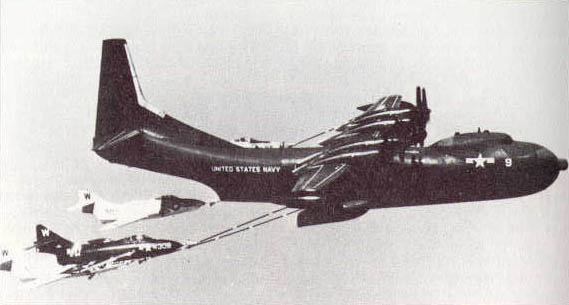




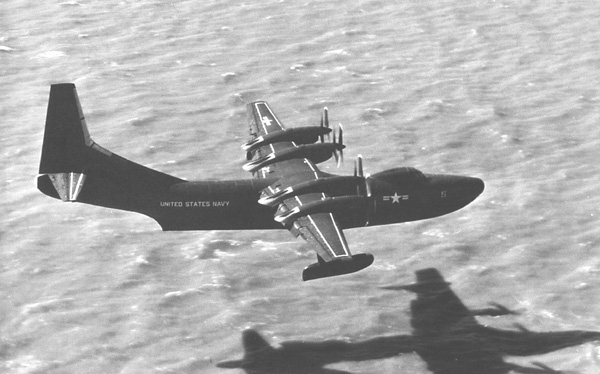
The R3Y-1
The first of five R3Y-1 Tradewind made its first flight on 25 February 1954. All armament and tailplane dihedral were deleted, a 3.05m (10ft) wide port-side cargo hatch aft of the wing was added, and the engine nacelles were redesigned to accept T40-A-10 engines. Air conditioning and cabin sound proofing were installed. Pressurized accomodation prodiveded for up to 103 passengers or 72 stretcher cases and twelve attendants in medevac congfiguration. The maximum cargo payload was 24.4 tonnes (24 tons).
The R3Y-2
Six R3Y-2 assault transports were build. These featured a hinged upward-opening nose section, providing an entrance 2.03 m (6 ft 8 in) high and 2.54 m (8 ft 4 in) wide through which men and equipment could be landed directly on the beach using the built-in ramp. The first flight was on 22 December 1954. In September 1956, a tanker-equipped R3Y-2 set a record by simultaneously refueling four Grumman F9F-8 Cougars.
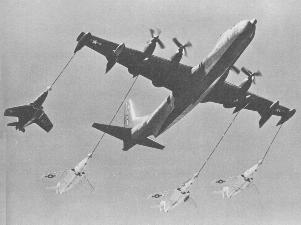
On 24 February 1955, one of the five R3Y-1s set a record which still stands by flying coast-to-coast with an average speed of 639 km/h (403 mph) during delivery to the Navy Test Center at Patuxent River, Maryland, taking advantage of the jetstream. On 18 October, a 6-hour 45-minute record flight was flown between Honolulu and NAS Alameda, California, at an average speed of 579 km/h (360 mph). The US Navy squadron VR-2 received the first of its mixed fleet of R3Y-1 and R3Y-2 Tradewinds on 31 March 1956.
Financial constrictions and continuin problems with the engine/propeller combination, which resulted in two in-flight separations of propellers and gearbox from an engine (on 10 May 1957 and 2 January 1958) led to the eventual early retirement of the R3Y. VR-2 was cut to two R3Y-1s and two R3Y-2s, and on 16 April 1958 the unit was disbanded. The aircraft were sold for scrap.
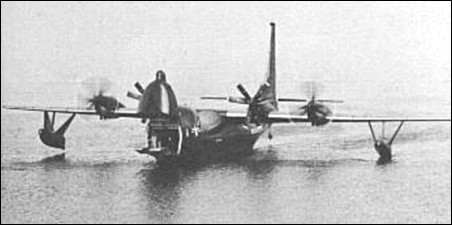
Convair R3Y-1 Specifications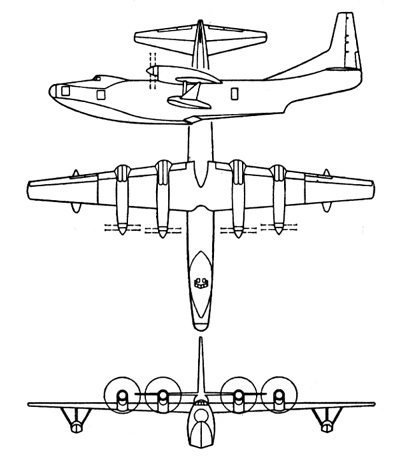 | |
| Type | Heavy transport flying boat |
| Powerplant | Four 4362 kW (5850 shp) Allison T40-A-10 turboprops |
| Armament | None |
| Performance | |
|---|---|
| Max speed | 624 km/h (388 mph) at 9144 m (30,000 ft) |
| Max speed at sea level | 598 km/h (372 mph) |
| Cruise speed | 483 km/h (300 mph) |
| Service ceiling | 12,100m (39,700 ft) |
| Maximum range | 6437km (4000 mi) |
| Dimensions | |
| Wingspan | 44.42 m (145 ft 9 in) |
| Length | 42.57 m (139 ft 8 in) |
| Height | 13.67m (44 ft 10 in) |
| Wing area | 640 m² (2102 sq ft) |
|
4 Jan 1936 - First flight of the SB2U 4 Jan 1996 - First flight of the Comanche 5 Jan 1954 - First flight of the MiG-19 5 Jan 1959 - The Rotodyne set a speed record of 190.46 mph in the convertiplane class 9 Jan 1941 - First flight of the Lancaster 9 Jan 1976 - The F-15 enters service at Langley AFB 10 Jan 1990 - First flight of the MD-11 12 Jan 1999 - The MiG 1.44 is unveiled 13 Jan 1960 - First flight of the CL-41 15 Jan 1957 - First flight of the production Javelin F(AW).6 17 Jan 1963 - First flight of the Shorts SC.7 Series 1 prototype 17 Jan 1970 - First flight of the T-6-2IG 19 Jan 1950 - First flight of the first of two YF-94Cs 19 Jan 1991 - First flight of the second X-31 20 Jan 1958 - First flight of the pre-production XP6M-1 20 Jan 1974 - First flight of the YF-16 |
21 Jan 1972 - First flight of the YS-3A 26 Jan 1954 - First flight of the Nord Gerfaut 17 Jan 1966 - First flight of the J-7 17 Jan 1995 - IOC of the C-17 17 Jan 1998 - Israel's first F-15I is delivered 17 Jan 2000 - The first MV-22B is delivered to the USMC 17 Jan 2000 - First flight of the CH-60S 19 Jan 1956 - First flight of the Supermarine Type 544 (Schimitar) prototype 21 Jan 1972 - First flight of the first YS-3A 21 Jan 1991 - First flight of the CT-4C Airtrainer 24 Jan 1951 - The X-4 makes its fastest flight, to over Mach 0.92 24 Jan 1975 - First flight of the Dauphin 2 24 Jan 2000 - The S-37 is flown supersonically for the first time 25 Jan 1983 - First flight of the first SF340 prototype 27 Jan 1939 - The P-38 prototype makes its first flight 29 Jan 1977 - First flight of the J-22/IAR-92 two-seater 31 Jan 1958 - First flight of the first T2J-1 (T-2) |